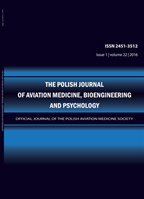2021, Volume 27, Issue 1
REASONS FOR FAILED EJECTIONS IN THE POLISH AIR FORCE IN THE YEARS 1951-2021
MARIAN MACANDER1
-------------------------------------------------------------------------------------------------
1Air Accident Investigation Laboratory, Department of Psychophysiological Measurements and Human Factor Research, Military Institute of Aviation Medicine
Autor korenspondencyjny: MARIAN MACANDER; Air Accident Investigation Laboratory, Department of Psychophysiological Measurements and Human Factor Research, Military Institute of Aviation Medicine; email: mmacander@wiml.waw.pl
Full text
Streszczenie
Introduction: The primary task of an ejection seat is to help the pilot safely exit an inoperable aircraft. The factor that ejects the seat from the aircraft cockpit is a powder charge or rocket engine. Injuries sustained by the crew during catapulting depend on several factors, including, but not limited to, the sequence of ejection times and the speed of the decision. Most modern military jets are equipped with rocket ejection systems. The TS-11 “ISKRA” aircraft, equipped with a powder charge ejection seat, was in use by the Polish Air Force until 2022. The present study was undertaken by the author to analyze the causes of failed ejections in the Polish Air Force between 1951 and 2021.
Methods: The author created a medical form based on a serious airplane accident. He analyzed all the ejections, studying the minutes of the commissions investigating aviation accidents between 1951 and 2021. The data received were entered into a form and then statistically analyzed. The author set out to determine the relationship between the characteristics of the ejection process and the types of injuries sustained by ejecting pilots. The results were analyzed for various injuries with a special focus on fatal injury cases.
Results: Analysis included approval of 281 completed forms from severe aviation accidents between 1951 and 2021. The rate of failed ejections was 25.27% of the total. It ranks among the highest in military aviation compared to other such studies. The most important factor hindering safe ejecting was deciding to leave the aircraft cockpit too late.
Discussion and Conclusion: The ejection seat has saved the lives of thousands of aircrews since its introduction in the 1940s. Using it is generally a safe life-saving measure. However, a number of factors may cause potential damage during ejection. These include the rapidity of the pilot's decisions, the task at hand, the aircraft's position, flight altitude or weather conditions.
Słowa kluczowe
ejecting, military pilot, fatal injuries, late decisions
